Insights
Backlink Audit Tools: How to Use Them Effectively from A to Z
On Digitals
24/11/2025
35
Backlink audit tools are powerful solutions that help you understand the full picture of links pointing to your website. They reveal which links add value and which pose hidden risks. Used correctly, backlink audit tools act as the quiet bodyguards that protect your SEO rankings.
At On Digitals, we stay on top of these trends to help businesses boost SEO performance with modern auditing solutions. Let’s explore how to get the most from the best backlink audit tools below.
What Is a Backlink Audit?
A backlink audit is the process of analyzing all backlinks, links from other websites to yours, to assess their quality, credibility, and SEO impact.
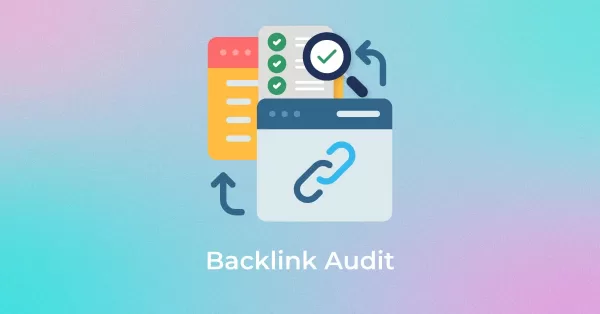
Tools that audit your backlinks for quality and impact
What Is the Purpose of a Backlink Audit?
A comprehensive backlink audit can help you:
- Identify high-quality backlinks: Links from authoritative, topically relevant websites that can increase your site’s authority and rankings.
- Spot risky backlinks that may trigger Google penalties: Links from spammy, irrelevant, or low-quality sites can drag down rankings or lead to penalties.
- Evaluate the overall quality of your backlink profile.
- Find opportunities to improve: Double down on good links and submit a disavow file via Google Search Console to ask Google to ignore harmful links.
- Review the effectiveness of past link-building efforts.
In short, the goal isn’t just to label links as good or bad, it’s to understand how each link influences your site’s overall performance so you can optimize SEO strategy intelligently.
Best Backlink Audit Tools in 2025
To run effective backlink audits, you need the right tools, and to know when and how to use them. Below are reliable options, both free and paid.
Google Search Console
One of the most powerful free backlink audit tools provided directly by Google. It helps website owners monitor search performance, diagnose crawling issues, and analyze inbound backlinks that affect SEO.
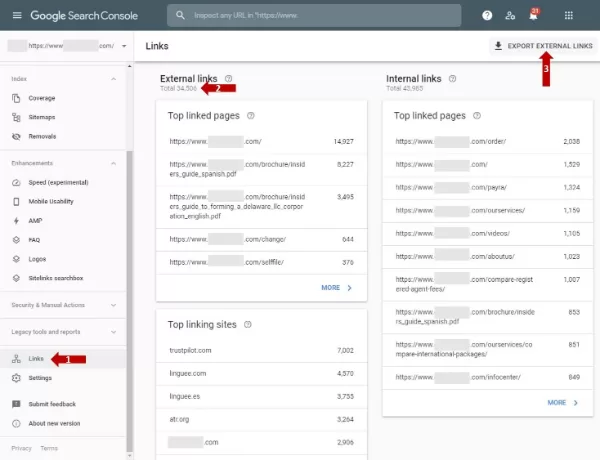
Audit inbound links easily with Google Search Console
What you can see with GSC:
- A list of backlinks pointing to your site
- Referring pages and destination pages
- Data on anchor text, internal links, and top linking sites
- Keyword performance reports, impressions, and CTR in search results
Pros of Google Search Console
- Completely free; data comes directly from Google
- Easy interface for beginners and pros alike
- Helps detect harmful links and streamlines disavow preparation
- Extra technical SEO data (page experience, indexing status, Core Web Vitals)
Cons of Google Search Console
- Backlink coverage is less complete than specialized tools (Ahrefs, SEMrush)
- No DR/DA, Spam Score, or Toxicity metrics
- Provides less link context than dedicated backlink platforms
Pricing: Free forever once your site is verified.
Ahrefs
Among the most popular and powerful backlink audit tools, trusted by SEO professionals to track, analyze, and optimize backlink profiles. Its massive index and fast crawling reveal how links influence rankings.
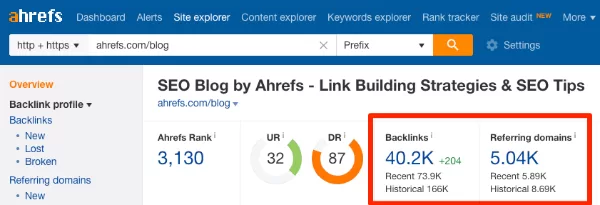
Ahrefs delivers deep backlink audits with rich data
What you can see with Ahrefs:
- Detailed referring domains, backlinks, anchor text, dofollow/nofollow ratio
- Domain Rating (DR), URL Rating (UR), and estimated traffic per link
- Historical backlink growth/decline charts
- Daily New and Lost Links reports
Pros of Ahrefs
- Rich link context beyond what GSC provides
- Large, frequently updated index with strong accuracy
- Clear visualizations and helpful charts
- Robust competitive analysis features
Cons of Ahrefs: No free plan; trials are limited
Pricing: From $99/month (Lite) to $999/month (Enterprise).
Moz Link Explorer
Ideal for newcomers in the backlink tools category. Moz focuses on helping users understand the strength and risk of each link.

Analyze link authority and risk levels with Moz
What you can see with Moz:
- Inbound links, top linking domains
- Domain Authority (DA) and Spam Score
Pros of Moz
- Simple, beginner-friendly interface
- Spam Score quickly highlights risky links
- Competitor backlink comparisons
Cons of Moz
- Slower data updates than Ahrefs or SEMrush
- Some advanced features require higher-tier plans
Pricing: From $99/month, with a 30-day free trial and limited free Link Explorer features.
Majestic
Known for its proprietary Trust Flow and Citation Flow metrics to assess backlink credibility and popularity. A long-standing favorite among experienced SEOs.
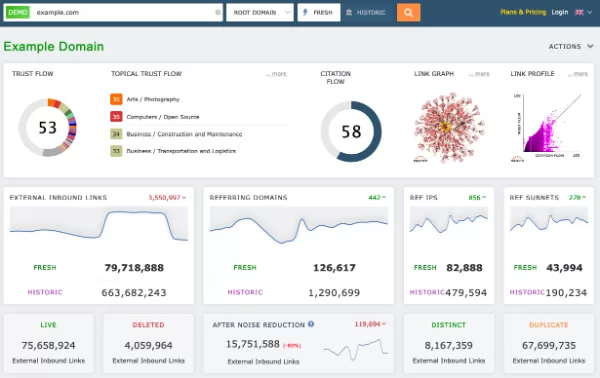
Assess backlink strength through Majestic’s Flow scores
What you can see with Majestic:
- Referring domains and external backlinks
- Topical Trust Flow charts revealing linking site topics
Pros of Majestic
- Strong trust/relevance diagnostics
- Deep export/reporting for advanced analysis
- Multi-domain comparisons
Cons of Majestic
- Older UI; steeper learning curve for beginners
- Lacks content and keyword research features
Pricing: Lite $49.99/month, Pro $99.99/month; no free plan (limited demo available).
SEMrush
More than a backlink checker, SEMrush is an all-in-one SEO platform with powerful backlink audit tools, keyword research, and competitive analysis in one place.
What you can see with SEMrush:
- Toxic backlink detection, Authority Score, anchor text analysis
- Automatic disavow file creation for Google
Pros of SEMRush
- Modern, intuitive interface
- Clear toxic-link scoring for faster decisions
- Frequently updated, reliable data
- Integrates with Google Analytics and Google Search Console
Cons of SEMRush
- Pricier than some alternatives
- Certain features are locked to higher-tier plans
Pricing: Pro $129.95/month, Guru $249.95/month, Business $499.95/month (limited free plan available).
Every backlink audit tool has its strengths, from data depth to toxic link detection. The right choice depends on your scope, budget, and SEO goals.
How to Choose the Right Backlink Audits Tools
Selecting the right backlink audit tools is essential for optimizing strategy and controlling link quality efficiently. Consider:
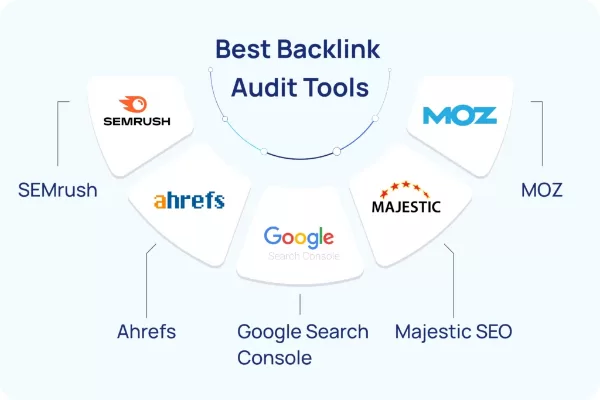
Top backlink audit tools to guide your SEO decisions
- Your goal: Basic backlink monitoring or deep analysis?
- For monitoring: start with free backlink audit tools like Google Search Console.
- For comprehensive audits: choose Ahrefs, SEMrush, or Majestic.
- Data depth & freshness: Prefer tools with large, frequently updated indexes to catch toxic links promptly (Ahrefs, SEMrush excel here).
- Usability & reporting: A good backlink tool should have a clear dashboard and flexible exports (PDF/CSV). Beginners often prefer Moz or GSC.
- Budget & usage model:
- Free tools are great for small projects.
- Pro/Business plans suit agencies and larger teams.
- Integrations & automation: Prioritize tools that connect with Google Analytics, GSC, and your SEO stack for end-to-end tracking.
Combining 2–3 backlink audit tools improves data validation and lets you leverage each platform’s strengths—building a stronger, safer backlink profile.
7 Tips to Backlink Audits Successfully And Tools You Can Use
Once you’ve prepared your backlink audit tools, you can start auditing and optimizing backlinks. Here are seven practical steps (with tool suggestions):
Assess your site’s baseline
Before starting your backlink audits, you need a comprehensive overview of your website’s backlink profile and its key performance metrics. Using reliable backlink audit tools like Ahrefs or SEMrush will help you collect accurate, up-to-date data for your analysis.
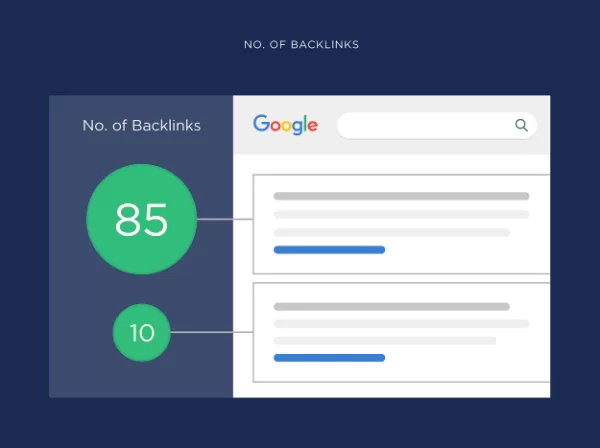
Assess backlink metrics before starting your audit
Essential metrics to monitor include:
- Total number of backlinks: Count all links pointing to your site, including multiple links from the same domain.
- Number of referring domains: The more high-quality domains link to you, the stronger your website’s authority becomes.
- Dofollow link ratio: These links pass ranking power and are more valuable for SEO than no-follow links.
- Domain Authority (DA) / Domain Rating (DR): Measure your site’s overall trust and authority, check DR in Ahrefs or DA in Moz to evaluate credibility.
Regularly tracking these metrics through trusted backlink audit tools ensures you maintain a healthy and authoritative link profile, an essential foundation for any successful SEO strategy.
Analyze your data
After gathering key metrics during your website evaluation, the next step in your backlink audits is to analyze the data to understand the quality of your backlink profile and determine the right optimization actions. You can use reliable backlink audit tools such as Ahrefs, SEMrush, or Majestic to categorize and assess each link accurately.
Common backlink classifications
- High-quality backlinks:
These are links from authoritative and trustworthy websites, with strong metrics like Domain Rating (DR) or Domain Authority (DA). They often come from:
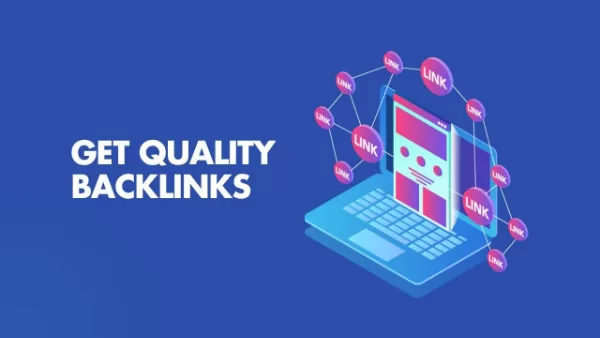
High-quality backlinks drive stronger ranking gains
- Reputable news sites or niche industry blogs
- Trusted organizations, universities, or companies within your field. These links significantly enhance your site’s authority and rankings.
- Moderate-quality backlinks:
These links come from websites with acceptable credibility. Although they may not boost rankings strongly, they still help maintain a diverse and balanced backlink profile. It’s worth keeping them, but not necessarily focusing on expanding this group. - Toxic backlinks:
These are harmful links that can damage your SEO performance. They usually come from spammy, irrelevant, or paid-link networks. If identified, use Google’s Disavow Tool to request that these backlinks be ignored.
Regularly repeat your backlink analysis using trusted backlink tools to detect new toxic backlinks early and protect your website’s ranking from future Google algorithm updates.
Refresh underperforming content
One of the most effective ways to improve your backlink audits is by refreshing old content to recover or boost organic traffic. Update outdated information, add new target keywords, and enhance readability to increase ranking potential.
Use backlink tools like Ahrefs or SEMrush to analyze traffic for each page. If you find pages with many high-quality backlinks but low traffic, that’s a clear signal the content needs to be updated.

Update low-performing pages to boost SEO and traffic
Common reasons include:
- Outdated content that no longer aligns with current search trends.
- Pages not fully optimized for on-page SEO (meta tags, headings, keywords).
- Content that doesn’t match user search intent effectively.
After making updates, monitor results using Google Search Console to measure changes in impressions, CTR, and keyword rankings.
Disavow toxic backlinks
During your backlink audits, identifying and removing toxic backlinks is essential to prevent Google penalties and ranking drops. Advanced backlink audit tools like SEMrush and Ahrefs can help you pinpoint suspicious or harmful links using Toxic Score or Spam Score metrics.

Remove harmful links to prevent ranking penalties
How to manage toxic backlinks:
- Contact the site owner to request link removal.
- If unsuccessful, create and submit a Disavow File through Google Search Console to tell Google to ignore those backlinks.
- Regularly monitor to ensure the harmful links don’t reappear.
Always double-check before disavowing. Only remove links that are truly toxic—mistakenly disavowing legitimate backlinks can reduce your website’s authority.
Track backlink performance
Once your backlink profile is clean, it’s time to track how your backlinks perform. This helps you identify which links bring the most traffic, referrals, or keyword ranking improvements.

Check which links deliver the strongest SEO results
Recommended tools:
- Google Analytics: Monitor referral traffic from each backlink.
- Ahrefs and SEMrush: Analyze referring domains, backlink traffic, and ranking trends over time.
- Google Search Console: Check which pages receive the most backlinks and their overall performance.
Create a dashboard to visualize backlink metrics monthly—this makes it easy to track performance trends and spot sudden drops or growth in link effectiveness.
Discover Link Opportunities
Once you understand your current backlink profile, you can expand your strategy by finding new link-building opportunities. Use backlink audit tools like Ahrefs Link Intersect, SEMrush Backlink Gap, or Moz Link Explorer to identify websites linking to your competitors but not to you.

Discover valuable backlink prospects with audit tools
How to do it:
- Enter your domain and competitor domains into the tool.
- Filter for relevant, high-authority websites in your niche.
- Reach out via email outreach, guest posting, or content partnerships.
Remember that quality matters more than quantity. Focus on backlinks from credible and relevant sources rather than chasing sheer volume.
Perform Regular Backlink Audits
SEO isn’t a one-time task, performing regular backlink audits ensures your backlink profile remains clean, stable, and compliant with Google’s evolving algorithms.
Recommended frequency:
- Conduct a full backlink audit every 3–6 months using Ahrefs or SEMrush.
- Set up automated alerts for new or lost backlinks.
- Compare quarterly audit data to identify trends and track improvements.
Think of backlink audits as an ongoing part of your SEO strategy, working alongside content refreshes, on-page optimization, and quality link building to achieve long-term, sustainable growth.
Completing all seven steps of backlink audits helps you maintain a strong, healthy backlink profile and ensures your off-page SEO continues to improve steadily. Combining both free and premium backlink audit tools allows you to balance cost-efficiency with high-quality insights, maximizing results without overspending.
FAQs
How often should I use backlink audit tools to monitor my website’s link profile?
It’s best to use backlink audit tools every 3–6 months, depending on your site’s size and activity. Regular monitoring helps you detect new backlinks, identify toxic links early, and keep your SEO performance stable against Google algorithm updates.
Are free backlink audit tools enough for small businesses?
Free backlink audit tools like Google Search Console are a great starting point for small websites. However, as your SEO strategy grows, investing in premium tools such as Ahrefs or SEMrush provides deeper insights, larger databases, and more advanced link analysis.
Can backlink audit tools help improve my content strategy?
By analyzing which pages attract the most backlinks, backlink audit tools reveal what type of content earns natural links. This helps you focus your efforts on creating high-performing, link-worthy content for future campaigns.

Improve content by learning what pages attract backlinks
What’s the difference between backlink audit tools and backlink tracking tools?
Backlink audit tools focus on evaluating the quality and SEO impact of your backlinks, while tracking tools mainly monitor changes over time—such as new or lost links. For a complete strategy, you should use both to maintain a healthy backlink profile.
Do backlink audit tools affect Google rankings directly?
Backlink audit tools themselves don’t boost rankings, but they help you identify harmful or low-quality backlinks that could be hurting your SEO. By removing or disavowing them, you strengthen your backlink profile and create better conditions for ranking improvement.
Master Backlink Audits Tools for Long-term SEO
Mastering the use of backlink audit tools is key to maintaining a clean, authoritative, and SEO-friendly backlink profile. By identifying high-quality links, removing toxic ones, and tracking performance regularly, you can strengthen your site’s authority and achieve long-term ranking stability.

Regular backlink audits secure long-term SEO growth
As a trusted digital marketing partner, On Digitals continues to empower businesses with advanced SEO solutions and strategic use of backlink audit tools. Our expertise helps brands uncover valuable link insights, enhance visibility, and build sustainable online growth.
NEWEST POSTS
Read more
